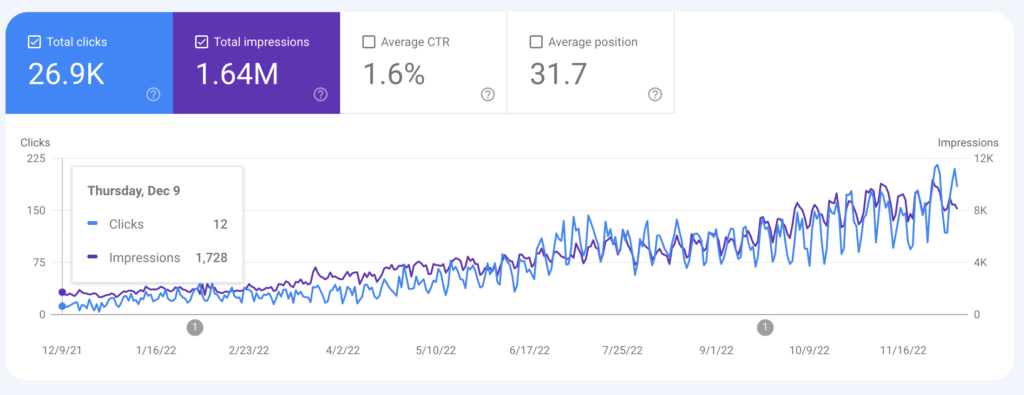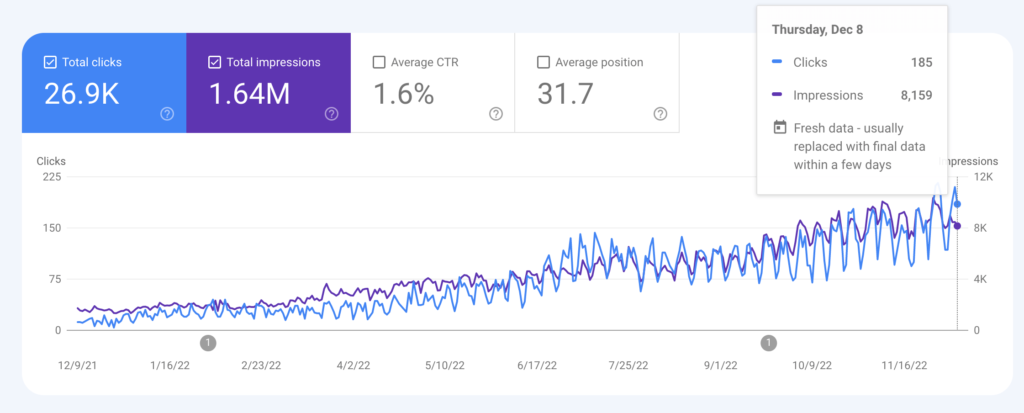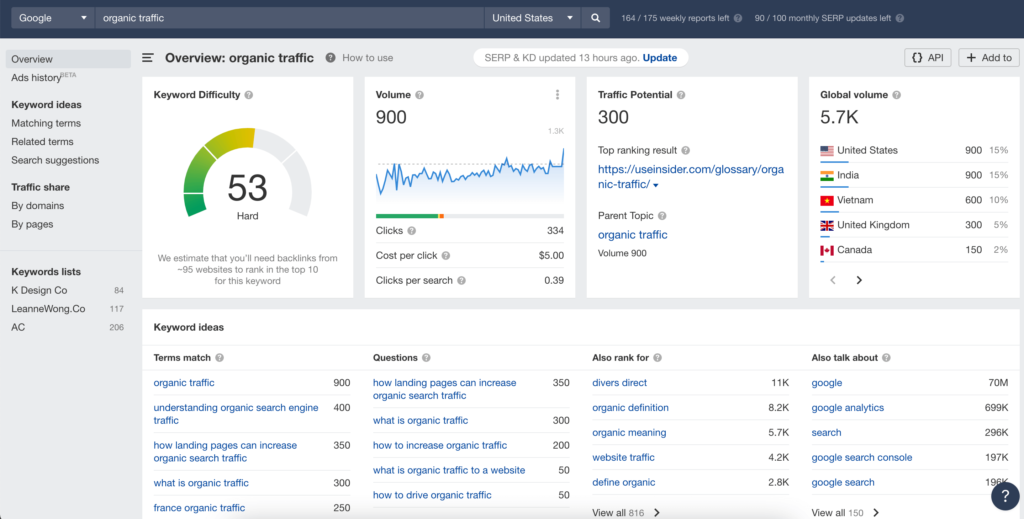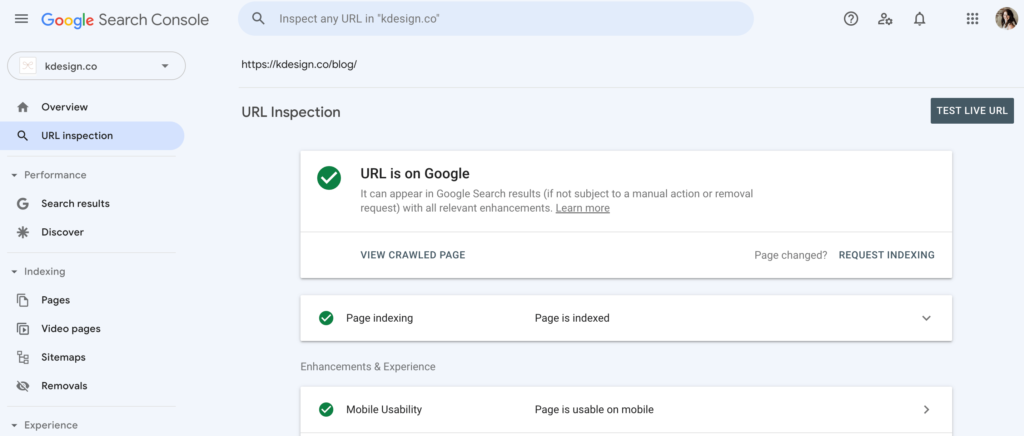At the end of 2021, I made a commitment that I would finally double-down on my SEO efforts in 2022. I wasn’t really sure what that would look like, but I knew I really wanted to focus on growing the organic traffic to my website.
I’ve been blogging for K Design Co. since I started it in 2014. Over the past 8 years, I’ve seen the effects of what consistently blogging can do for my business and my website, but I wanted to take things to the next level. With some a beginner’s working knowledge of how SEO works, I’ve done my best to do basic keyword research and optimize my blog content as best as I knew how, but I still felt like I was fumbling around in the dark when it came to SEO.
(This article contains affiliate links, which means I may receive a small commission for purchases made through links in this post at no extra cost to you. I only recommend products I 100% believe in. Read the Privacy Policy for details.)
That’s why I knew if I wanted 2022 to be any different, I was going to have do some things differently. Not just blog more, but actually rethink how I approach content creation and build an informed strategy around SEO. This commitment led to increasing my organic search traffic nearly ten-fold where I started from 512 organic search visits in January 2022 to 4.48k in November 2022.
You can see in my Google Search Console dashboard from December (2021) to December (2022), my organic search traffic (clicks) went from 12, to 185. That means 185 people found my website from Google Search in just one day and clicked through to my site.


Here are the 5 things I did to increase my organic search traffic in 2022.
1. I Hired an SEO coach.
I am one of those people who likes to figure things out myself. If someone asks me a question and I don’t know the answer, I’ll look it up and find it. This has served me well in many areas of my life, but sometimes it can prevent me from relying on others, when I really need to or should. For 7 years, I tried SEO my way, but I knew I still didn’t have all the information I needed to take me where I wanted to go. That’s why I knew it was time to bring in an expert.
A few years ago, I recalled taking an SEO course from Leanne Wong. It was a great learning experience and taught me all the basics of SEO, but I knew that I really needed more one-on-one support if I wanted to expand my knowledge and learn how to apply it to my business specifically. It was serendipitous then, that at the same time I was seeking out ways to improve my SEO, I received a marketing email from Leanne about one of her new service offerings, SEO coaching. I knew it wasn’t something I could pass up.
I worked closely with Leanne for the first 6 months of the year on my SEO strategy and put a lot of time and effort into implementing the SEO strategies and techniques she shared with me. It was one of the best investments I have ever made in my business, hands-down, because the results of work together are still compounding. The insights and guidance she shared with me, I can continue to build on and use in my business for years to come. If you are serious about your website’s SEO, or even taking your SEO skills to the next level for your clients, I couldn’t recommend working with Leanne more highly. She was instrumental in the growth of my organic traffic this year and I hope that I can continue working with her.

2. I subscribed to a paid SEO research tool.
Like many business owners do, I resisted adding yet, another monthly expense to my business. I tried for years to do my keyword research with the free tools you can get from MOZ or Neil Patel, that limit your daily or monthly keyword searches. Even though I could look up a few keyword here and there, the real problem with this was, I couldn’t look at my site’s SEO as a bigger picture.
I couldn’t track or see how my website was ranking for the terms I was trying to rank for. And I didn’t have the reporting features I needed to see what competitors were also ranking for those terms either. Not to be dramatic, but finally, making an investment in Ahrefs keyword research tool was life-changing (I promise this is not a sponsored post or even an affiliate link, Ahrefs is just truly that good). All of the information that had always felt like such a mystery, was suddenly at my fingertips and I had an expert, Leanne, to help me to learn how to use it for things like checking the rank of my website, doing competitor research and monitoring my organic SEO growth.
3. I re-identified my core content pillars.
Back when I started my blog, I had some general blog categories that I wanted to write about, but a lot has changed since then. I want to update my blogging topics to reflect those changes in my business. For me that meant adding “Showit“, “Fonts” and “Color Palettes” to my list of core topics / subtopics that I blog about, and letting other topics like “Print Design” and “Graphic Design” take a backseat. That doesn’t mean I can’t still write about those topics if I want to, but it makes sense to align my core topics with the specific services and products that I want to be found for. You can find links to my core blog topics and content pillars the at top of my blog feed.

Once I established those, I created core pillar blog posts, or “Ultimate Guides” that covered the those topics comprehensively and also inter-linked to several sub-topics, which dove even further on that supporting content. (I list out my “Ultimate Guide” posts now in my blog sidebar.) Some of these sub-topic posts were new posts that I developed based on keyword research and others were posts that I already had written that just needed “beefed-up”. Approaching my content creation in this 2-pronged way: 1) writing new posts and 2) optimizing existing posts, I believe was one of the main reasons I was able to improve my website rankings so much this year. That’s why I’m breaking down how I did that, more specifically, in the next two steps.
4. I wrote new blog posts based on targeted keyword research.
Using Ahrefs, I was able to identify keywords that I would consider low-hanging fruit. That is, keywords that didn’t have too high of a difficulty or competition score, but also had at least 100 in search volume. Knowing my domain authority rating was 45 (at the time – now it’s up to 56!), I tried to target keywords that were around the same difficulty rating or lower (but sometimes slightly higher). Then I would look for keywords that had a significant volume and still aligned with my core content pillar topics.
As I began using the keyword tool more and more, it felt like I had discovered a gold mine of untapped blog topics to write about. This research enabled me to develop new blog posts that started outranking some heavy-hitting competing domains like Pinterest, Canva and Mailchimp for the topics I was covering. I had people in my inbox from high-profile sites like Adobe and WP Engine asking for backlinks, which clued me in that I was finally onto something. Achieving this kind of status felt weirdly exciting and was also the first time I truly felt like I understood SEO, and “how to pull the levers” to see the results I wanted.

5. I optimized existing blog posts.
Blogging for 8 years meant I had quite a bit of already existing content on my site. But believe me, it wasn’t all SEO-optimized in the best way. Sure, each of my blog posts, had a few keywords throughout and a meta description, but that’s about as far as things went in terms of SEO. Using Ahrefs, I was able to lookup newer, more strategic keywords for some of my posts – meaning keywords I could actually rank for, were relevant to my audience and would bring me the organic traffic with the right search intent.
I was also able to look at competitors who ranked for that keyword, analyze their content and re-write my posts to include more optimized headings, images with ALT text to add better context to concepts I was explaining, and overall, better-written content that covered my topic more thoroughly.
These optimizations took quite a bit of time and most of those optimized posts ended up being over 2000 words, but it was all well-worth it. Once I optimized a blog post, I would have Google Search Console reindex my posts so Google knew that my content was fresh and updated. Sometimes within days, I would see the positive effects of the work I had done to improve that content.

So what’s next for my website’s organic search traffic?
Realizing such amazing success this year with my SEO has reignited my passion for blogging. It’s given me a new sense of purpose for writing and serving my audience to give them the answers they are looking for. Honestly, there are some days that’s all I want do.
My goal for 2022 was to reach 3K in monthly organic search visits per month. I was able to surpass this goal by almost 2K per month. My goal for 2023 was be to reach 20k in search per month by the end of the year. Not only did I also meet that goal, I surpassed it by nearly 5k search visitors per month!
My 2024 goal for organic search traffic is 100K visitors per month, which I know is pretty huge. I will update this post at the end of the year with an update on how I did.
Related Post: SEO Mistakes: 5 Reasons Your Website Isn’t Showing Up in Google
If you are wanting to increase your organic traffic this coming year, I encourage you take a look a second look at your SEO and blogging strategy. Try implementing some of these same optimization tactics with diligence and consistency and I guarantee you will see the results.













